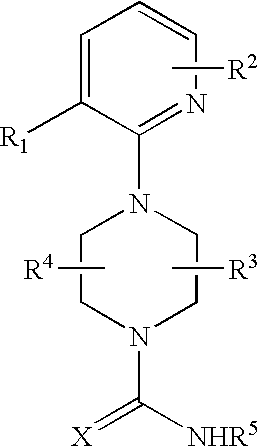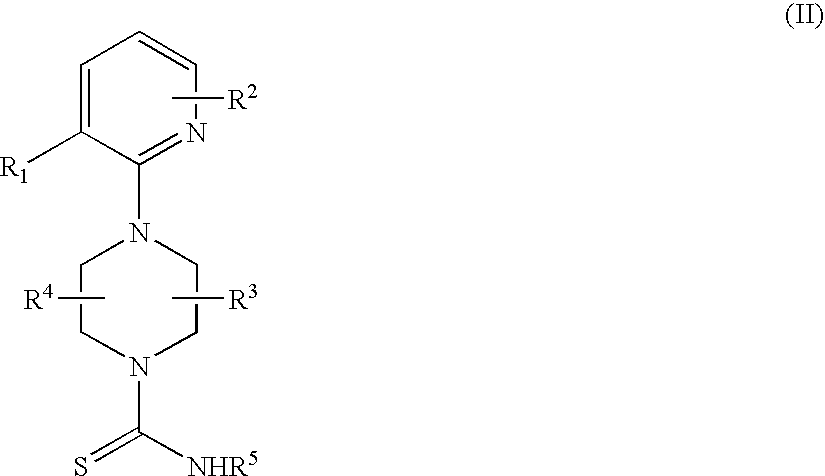Therapeutic agents useful for treating pain
a technology of therapeutic agents and compounds, applied in the field of piperazine compounds, to achieve the effect of inhibiting the function of mglur5
- Summary
- Abstract
- Description
- Claims
- Application Information
AI Technical Summary
Problems solved by technology
Method used
Image
Examples
example 1
5.1 Example 1
Synthesis of Compounds 1c-1k
[0633] 199200201202
[0634] 2,3-Dichloropyridine 1a (0.22 g, 1.45 mmol) and 1.1 eq. of piperazine (0.14 g, 1.59 mmol) were dissolved in 3 mL of dimethyl sulfoxide (DMSO) and the resulting mixture was heated at 85.degree. C. for 6 h. The reaction mixture was then cooled to room temperature and extracted with a saturated aqueous sodium bicarbonate solution. The organic layer was dried, concentrated, and purified using column chromatography to provide compound 1b as a yellow liquid.
[0635] Compounds 1c-k were made from compound 1b according to the following procedures:
[0636] 1c: To compound 1b (440 mg, 2.22 mmol) dissolved in 3 ml of DMF was added 1.0 eq. (0.17 ml, 0.32 g, 2.22 mmol) of the phenethyl isocyanate. The resulting reaction mixture was placed on a shaker at room temperature. The reaction was monitored by liquid chromatography-mass spectrmetry) LC / MS. After 30 min, the reaction product was isolated and purified using column chromatography...
example 2
5.2 Example 2
Synthesis of Compounds 2a and 2b
[0654] 203
[0655] Compounds 2a and 2b were prepared from compound 1b (prepared as in Example 1) according to the following procedures:
[0656] 2a: Compound 1b (440 mg, 2.22 mmol) was dissolved in 3 mL of dimethylformamide, 1 eq. (0.42 g, 2.22 mmol) of 4-tert-butylphenyl isothiocyanate was added to the solution, and the resulting reaction mixture placed on a shaker at room temperature. The reaction was monitored using LC / MS. After 30 min. the reaction product was isolated and purified using column chromatography (ethyl acetate / hexane) to provide 75.6 mg of 2a as a white solid.
[0657] 2b: Compound 1b (440 mg, 2.22 mmol) was dissolved in 3 mL of dimethylformamide, 1 eq. (0.39 g, 2.22 mmol) of 4-isopropylphenylisothioc-yanate was added to the solution, and the resulting reaction mixture placed on a shaker at room temperature. The reaction was monitored using LC / MS. After 30 min. the reaction product was isolated and purified using column chromato...
example 3
5.3 Example 3
Synthesis of Compounds 3a-3b
[0661] 204
[0662] Compounds 3a and 3b were prepared by the following procedures:
[0663] 3a: To compound 3q (0.25 g, 1.07 mmol) dissolved in 3 ml of DMSO was added 1.1 eq. (0.1 g, 1.17 mmol) of piperazine and the resulting reaction mixture placed on a shaker at 85.degree. C. for 4 h. After 4 h, the reaction mixture was cooled to room temperature, 1.1 eq. (0.21 g, 1.17 mmol) of 4-t-butyl-phenyl isocyanate added, and the mixture placed on a shaker at room temperature for 1 h. The reaction product was then isolated and purified using column chromatography (ethyl acetate / hexane) to provide 91.2 mg of 3a as a white solid.
[0664] 3b: To compound 3r (24 mg, 0.097 mmol) dissolved in 3 ml of DMSO was added 1.2 eq. (11 mg, 0.12 mmol) of piperazine and the resulting reaction mixture placed on a shaker at 85.degree. C. for 4 h. After 4 h, the reaction mixture was cooled to room temperature, 1.0 eq. (17 mg, 0.097 mmol) of 4-t-butyl-phenyl isocyanate added, an...
PUM
| Property | Measurement | Unit |
|---|---|---|
| temperature | aaaaa | aaaaa |
| temperature | aaaaa | aaaaa |
| volume | aaaaa | aaaaa |
Abstract
Description
Claims
Application Information
 Login to View More
Login to View More - R&D
- Intellectual Property
- Life Sciences
- Materials
- Tech Scout
- Unparalleled Data Quality
- Higher Quality Content
- 60% Fewer Hallucinations
Browse by: Latest US Patents, China's latest patents, Technical Efficacy Thesaurus, Application Domain, Technology Topic, Popular Technical Reports.
© 2025 PatSnap. All rights reserved.Legal|Privacy policy|Modern Slavery Act Transparency Statement|Sitemap|About US| Contact US: help@patsnap.com



